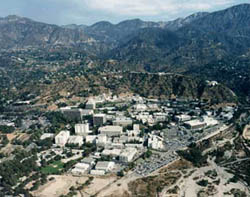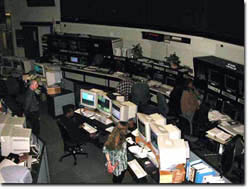
The Space Flight Operations Facility (SFOF) is located at the Jet Propulsion Laboratory (JPL) in Pasadena, California. This facility is where spacecraft tracking and scientific data are received and processed from the JPL's Deep Space Network. The JPL from the beginning of its association with the National Aeronautics and Space Administration (NASA) in 1958 has served as the primary NASA center for the unmanned exploration of the planets. The first version of the Space Flight Operations Facility was built in 1958 to support the Explorer 1 satellite. This mission control center was in a single room that housed all the communications, recording and other support necessary for Explorer 1. By 1961, with the coming of Project Ranger to explore the moon, it was obvious that a more elaborate mission control center was necessary. A new SFOF, replacing the Explorer 1 control center, was constructed as the focal point of the Deep Space Network--the hub of the vast communications network through which NASA controls its unmanned spacecraft flying in deep space.
Located in a three-story square building with a standby powerhouse extending from the basement on the west side, the new SFOF was constructed in 1963. All parts of the building, except for portions of the basement and the standby powerhouse, are air-conditioned to precise tolerances. At the heart of the SFOF is the Network Operations Control Center, which provides a centralized point for NASA's Deep Space Network. The Network Operations Control Center has two separate functional elements: Network Operations Control and Network Data Processing. The Network Operations Control Center houses consoles, video displays, projection screens, status and operation displays, closed circuit television communication links and telephones necessary to control and monitor deep space flight operations. The Network Data Processing Center houses the computers and the data storage and processing facilities necessary to support the Network Operations Control Center. Other areas of the building house offices, public viewing areas and additional support facilities for the Network Operations Control Center.

The Mariner, Viking, Pioneer and Voyager projects that have explored the planets and solar environment have all been controlled for at least part of their missions in this facility. The vast harvest of scientific information concerning the planets and the universe gathered by these spacecraft first saw the light of day and were read by technicians working in the SFOF. The SFOF is the symbol of the technology that explored the planets and brought back new discoveries to Earth, and it is the resource most closely associated with the unmanned planetary exploration program of the JPL and NASA. The Space Operations Facility is still an active NASA facility supporting various ongoing NASA projects and its equipment is continually modified and upgraded.
Visit the National Park Service Travel American Aviation to learn more about Aviation related Historic Sites.
Last updated: August 28, 2017
